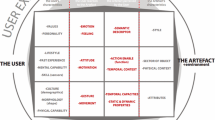Abstract
Metaphors are powerful cognitive instruments that help us in making sense of the world around us. We start using them already as very small children and they accompany us throughout our lives. Some authors go as far as claiming that all knowledge is metaphorical (Indurkhya 1994). But even if we do not subscribe to that position we cannot but admit that metaphors are an important cornerstone of human creativity (Seitz 1997). It therefore stands to reason that they might be useful in highly creative undertakings such as the development of information systems. The latter activity in particular is fraught with a principal problem: Most stakeholders in the system are not knowledgeable in system design and they find it very difficult — if not impossible — to envision a system that does not yet exist. It is not there to look at or to play with and in early stages there is not even a rudimentary prototype that could be studied. To imagine how a future system might look like, what functions it will have and how it will support and shape my daily work is well beyond the powers of most potential users of such a system. In this context a metaphor can be a powerful device for building a bridge from the known to the unknown. It draws on ideas that people are familiar with from their everyday experience.
Access this chapter
Tax calculation will be finalised at checkout
Purchases are for personal use only
Preview
Unable to display preview. Download preview PDF.
Similar content being viewed by others
References
Alexander C, Ishikawa S, Silverstein M, Jacobson M, Fiksdahl-King I, Angel S (1977) A Pattern Language: Towns, Buildings, Construction. Oxford University Press New York
Alexander C (1979) The Timeless Way of Building. Oxford University Press NY
Beck K (2000) Extreme Programming Explained. Addison-Wesley Longman Reading MA
Bunge M (1977) Ontology I: The Furniture of the World. Dordrecht Holland
Bunge M (1979) Ontology II: A World of Systems. Dordrecht Holland
Carroll JM, Mack RL, Kellogg WA (1988) Interface Metaphors and User Interface Design. In: Helander M (ed) Handbook of Human-Computer Interaction. Elsevier Science Publishers Amsterdam The Netherlands
Coyne R (1995) Designing Information Technology in the Postmodern Age: From Method to Metaphor. The MIT Press Cambridge MA
Evermann J, Wand Y (2001) Towards Ontologically Based Semantics for UML Constructs. Proc of the 20th International Conf on Conceptual Modeling: Conceptual Modeling — ER 2001. Yokohama Japan November 27–30 2001
Forsgren O (1991) Co-Constructive Computer Applications: Core Ideas and Some Complementary Strategies in the Development of a Humanistic Computer Science. In: Bazewicz M (ed) Information Systems Architecture and Technologies — ISAT’91. Politechnika Wroclawska Wroclaw
Gamma E, Helm R, Johnson R, Vlissides J (1995) Design Patterns: Elements of Reusable Object-Oriented Software. Addison-Wesley Reading MA
Gazendam HWM (1999) Information System Metaphors. Journal of Management and Economics, vol 3, no 3
Gentner D (1983) Structure Mapping: A Theoretical Framework for Analogy. Cognitive Science. vol 7, no 2, pp 155–170
Gentner D, Falkenhainer B, Skorstad J (1988) Viewing Metaphor as Analogy: The Good, The Bad and The Ugly. In: Helma DH (ed) Analogical Reasoning: Perspectives of Artificial Intelligence, Cognitive Science and Philosophy. Kluwer Dordrecht The Netherlands
Indurkhya B (1994) The Thesis That All Knowledge Is Metaphorical and Meanings of Metaphor. Metaphor and Symbolic Activity, vol 9, no 1, pp 61–63
Lakoff G, Johnson M (1980) Metaphors we Live By. The University of Chicago Press Chicago
Liu K, Sun L, Bennett K (2002) Co-Design of Business and IT Systems. Information Systems Frontiers, vol 4, no 3, pp 251–256
Madsen KH (1994) A Guide to Metaphorical Design. Communications of the ACM, vol 37, no 12, pp 57–62
McCloskey DN (1998) The Rhetoric of Economics. University of Wisconsin Press Madison WI
Morgan G(1997) Images of Organisation. 2nd ed. Sage Beverly Hills
OMG (2003) Unified Modeling Language Specification: Version 1.5. Object Management Group Needham MA USA. www.omg.org/docs/formal/Od-O’I-O 1.pdf
Opdahl AL, Henderson-Sellers B (2002) Ontological Evaluation of the UML Using the Bunge-Wand-Weber Model. Software and Systems Modeling, vol 1, no 1, pp 43–67
Opdahl AL, Henderson-Sellers B (2004) A Template for Defining Enterprise Modeling Constructs. Journal of Database Management, vol 15, no 2, pp 39–73
Seitz JA (1997) The Development of Metaphoric Understanding: Implications for a Theory of Creativity. Creativity Research Journal, vol 10, no 4, pp 347–353
Trætteberg H (2000) Model Based Design Patterns. Position Paper Workshop on User Interface Design Patterns CHI’2000 The Netherlands
Walsham G (1991) Organizational Metaphors and Information Systems Research. European Journal of Information Systems, vol 1, no 2, pp 83–94
Wand Y, Weber R (1989) An Ontological Evaluation of Systems Analysis and Design Methods. In: Falkenberg ED, Lindgreen P (eds) Information Systems Concepts: An In-Depth Analysis. North-Holland
Wand Y, Weber R (1990) An Ontological Model of an Information System. IEEE Transactions on Software Engineering, vol 16, no 11, pp 1282–1292
Wand Y, Weber R (1995) On the Deep Structure of Information Systems. Information Systems Journal, no 5, pp 203–223
Weber R (1997) Ontological Foundations of Information Systems. Melbourne
Author information
Authors and Affiliations
Editor information
Editors and Affiliations
Rights and permissions
Copyright information
© 2006 Springer Science-Business Media, LLC
About this paper
Cite this paper
Rittgen, P. (2006). Translating Metaphors into Design Patterns. In: Nilsson, A.G., Gustas, R., Wojtkowski, W., Wojtkowski, W.G., Wrycza, S., Zupančič, J. (eds) Advances in Information Systems Development. Springer, Boston, MA. https://doi.org/10.1007/978-0-387-36402-5_36
Download citation
DOI: https://doi.org/10.1007/978-0-387-36402-5_36
Publisher Name: Springer, Boston, MA
Print ISBN: 978-0-387-30834-0
Online ISBN: 978-0-387-36402-5
eBook Packages: Computer ScienceComputer Science (R0)




